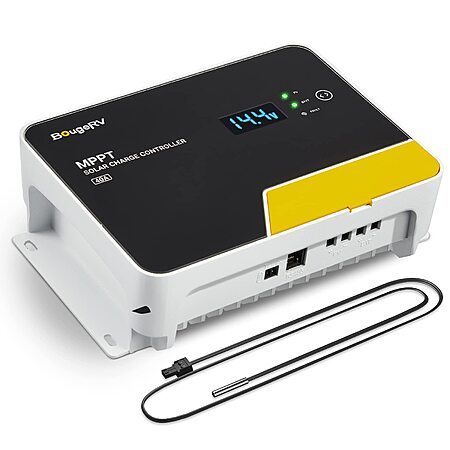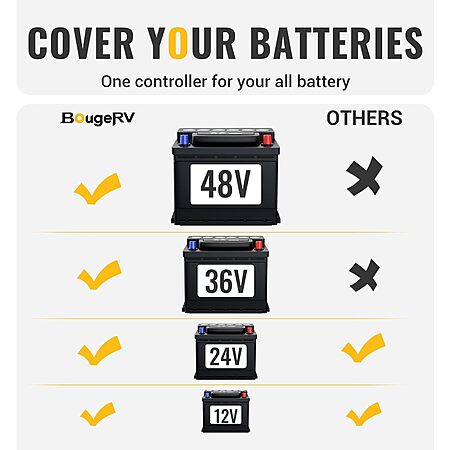BougeRV via Amazon has
BougeRV 40 Amp MPPT Solar Charge Controller w/ App Control on sale for $159.99 - $40 clip coupon =
$119.99.
Shipping is free.
Thanks to Community Member
lobo411 for sharing this deal.
- Note: You must be logged in to clip coupons; coupons are typically for one-time use.
About this Item:
- System Grounded: Negative Ground
- System Voltage: 12V/24V/36V/48V
- Compatible Battery Type: FLD/GEL/SLD/Li/AGM
- Rated Charging Current: 40Amp
- Maximum PV Input Voltage: <150V
- Maximum Input of PV System: 600W/12V; 1200W/24V; 1800W/36V; 2400W/48V
- Remote Control Signal Range: 15 Feet
- Temperature Sensor: 6.5 Feet
- Working Temperature: -31℉ to 113℉
- Protection Level: IP34
- Altitude: ≤3000m
- Net Weight: 0.64 lb
- Dimensions: 8.6x5.9x2.6 inches
- Installation Size: 8.1x2.4 inches






Leave a Comment
Top Comments
24 Comments
Sign up for a Slickdeals account to remove this ad.
An MPPT (Maximum Power Point Tracking) controller is an advanced type of solar charge controller used in solar power systems to maximize the efficiency of solar panels. It is an essential component for maximizing the efficiency of solar power systems, particularly when using higher-voltage solar panels or in systems requiring efficient energy conversion.Here's how it works and why it's beneficial:
Key Features of MPPT Controllers
1. Maximizing Power Output
- Solar panels have a "maximum power point" where they produce the highest power (Watts = Voltage x Current).
- This point varies based on sunlight intensity, temperature, and panel characteristics.
- An MPPT controller continuously tracks this point and adjusts its operation to extract the maximum power from the panels.
2. Voltage Conversion
- MPPT controllers can step down higher voltage from solar panels to match the voltage of your battery bank while increasing the current to ensure efficient charging.
- For example, a 24V panel can efficiently charge a 12V battery without wasting energy.
3. Increased Efficiency:
- Compared to traditional PWM (Pulse Width Modulation) controllers, MPPT controllers are typically 30-40% more efficient, especially in less-than-optimal conditions like low light or cold weather.
4. Compatibility with Battery Types:
- The MPPT controller you're looking at is compatible with various battery types, including **LiFePO4**, **AGM**, **Gel**, and others, which ensures proper charging for each type's specific requirements.
5. Temperature Compensation:
- It includes a temperature sensor to adjust the charging parameters to protect the battery in varying temperature conditions.
6. Remote Monitoring and Control:
- This specific model has a **remote app control** feature, allowing you to monitor and manage your solar power system conveniently from your phone.
Our community has rated this post as helpful. If you agree, why not thank alphakp295
I'm not affiliated in any way, just sharing the info in case it's helpful for someone.
An MPPT (Maximum Power Point Tracking) controller is an advanced type of solar charge controller used in solar power systems to maximize the efficiency of solar panels. It is an essential component for maximizing the efficiency of solar power systems, particularly when using higher-voltage solar panels or in systems requiring efficient energy conversion.Here's how it works and why it's beneficial:
Key Features of MPPT Controllers
1. Maximizing Power Output
- Solar panels have a "maximum power point" where they produce the highest power (Watts = Voltage x Current).
- This point varies based on sunlight intensity, temperature, and panel characteristics.
- An MPPT controller continuously tracks this point and adjusts its operation to extract the maximum power from the panels.
2. Voltage Conversion
- MPPT controllers can step down higher voltage from solar panels to match the voltage of your battery bank while increasing the current to ensure efficient charging.
- For example, a 24V panel can efficiently charge a 12V battery without wasting energy.
3. Increased Efficiency:
- Compared to traditional PWM (Pulse Width Modulation) controllers, MPPT controllers are typically 30-40% more efficient, especially in less-than-optimal conditions like low light or cold weather.
4. Compatibility with Battery Types:
- The MPPT controller you're looking at is compatible with various battery types, including **LiFePO4**, **AGM**, **Gel**, and others, which ensures proper charging for each type's specific requirements.
5. Temperature Compensation:
- It includes a temperature sensor to adjust the charging parameters to protect the battery in varying temperature conditions.
6. Remote Monitoring and Control:
- This specific model has a **remote app control** feature, allowing you to monitor and manage your solar power system conveniently from your phone.
Our community has rated this post as helpful. If you agree, why not thank rune87
Sign up for a Slickdeals account to remove this ad.
I'm thinking for a shed I'd only need about an 1kw inverter.
I'm thinking for a shed I'd only need about an 1kw inverter.
Lower cost inverters are almost always high frequency which works fine for resistance loads, but may have difficulty with larger inductive loads like starting a large motor, compressors, water pumps.... Ex. A 1000w low frequency inverter could probably power a miter saw, but a 1000w high frequency inverter probably wouldn't be able to handle the inrush Amps needed.
Sign up for a Slickdeals account to remove this ad.
I'm thinking for a shed I'd only need about an 1kw inverter.
If you want to add outlets, you'll want a useable couple thousand watts at minimum and make a proper 15 or 20 amp circuit. That way you can use common power tools and whatever like your household outlets without second guessing capabilities...and of course how much battery and solar once again depending on how much usage you need.
Leave a Comment